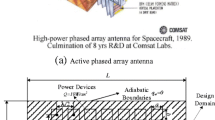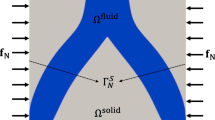Abstract
This paper proposes a multidisciplinary topology optimization design model and method for the cold plate of active phased antenna array. Aiming at the characteristics of multidisciplinary integration of active phased antenna array, a multidisciplinary analysis model considering the thermal effect is established. Based on the multidisciplinary analysis model of antenna array, topology optimization method is used to establish a multidisciplinary optimal design model for the cold plate of antenna array. Since there is no explicit relationship between the electrical performance indicators of the antenna and the topological design variables, the adjoint method is used to derive the adjoint-governing equations that simultaneously consider fluid flow, system heat dissipation, and antenna electrical performance. The corresponding sensitivity information is obtained by solving the adjoint-governing equation. The correctness and effectiveness of the proposed model and method are verified by typical cases.











Similar content being viewed by others
References
Alexandersen J, Aage N, Andreasen CS, Sigmund O (2014) Topology optimisation for natural convection problems. Int J Numer Methods Fluids 76:699–721. https://doi.org/10.1002/fld.3954
Alexandersen J, Sigmund O, Aage N (2016) Large scale three-dimensional topology optimisation of heat sinks cooled by natural convection. Int J Heat Mass Transf 100:876–891. https://doi.org/10.1016/j.ijheatmasstransfer.2016.05.013
Balanis CA (2016) Antenna theory: analysis and design. Wiley, Hoboken
Dede EM (2009) Multiphysics topology optimization of heat transfer and fluid flow systems. In: Proceedings of the COMSOL users conference.
Deng Y, Wu Y, Liu Z (2018) Topology optimization theory for laminar flow. Springer, Singapore, p XI, 250
Haertel JHK, Nellis GF (2017) A fully developed flow thermofluid model for topology optimization of 3D-printed air-cooled heat exchangers. Appl Therm Eng 119:10–24. https://doi.org/10.1016/j.applthermaleng.2017.03.030
Haertel J, Engelbrecht K, Lazarov BS, Sigmund O (2018) Topology optimization of a pseudo 3D thermofluid heat sink model. Int J Heat Mass Transf 121:1073–1088. https://doi.org/10.1016/j.ijheatmasstransfer.2018.01.078
Han X-h, Liu H-l, Xie G, Sang L, Zhou J (2021) Topology optimization for spider web heat sinks for electronic cooling. Appl Therm Eng 195:117154. https://doi.org/10.1016/j.applthermaleng.2021.117154
Koga AA, Lopes ECC, Villa Nova HF, Lima CRd, Silva ECN (2013) Development of heat sink device by using topology optimization. Int J Heat Mass Transf 64:759–772. https://doi.org/10.1016/j.ijheatmasstransfer.2013.05.007
Li H, Ding X, Meng F, Jing D, Xiong M (2019) Optimal design and thermal modelling for liquid-cooled heat sink based on multi-objective topology optimization: an experimental and numerical study. Int J Heat Mass Transfer. https://doi.org/10.1016/j.ijheatmasstransfer.2019.118638
Li H, Kondoh T, Jolivet P, Furuta K, Yamada T, Zhu B, Zhang H, Izui K, Nishiwaki S (2022) Optimum design and thermal modeling for 2D and 3D natural convection problems incorporating level set‐based topology optimization with body‐fitted mesh. Int J Numer Methods Eng 123(9):1954–1990. https://doi.org/10.1002/nme.v123.910.1002/nme.6923
Lou S, Wang W, Qian S, Ge C (2019) A fast pattern computation method for deformed antenna arrays. IEEE Antennas Wirel Propag Lett 18:1838–1842. https://doi.org/10.1109/lawp.2019.2931333
Marck G, Nemer M, Harion J-L (2013) Topology optimization of heat and mass transfer problems: Laminar flow. Numer Heat Transf Part B 63:508–539. https://doi.org/10.1080/10407790.2013.772001
Qian S, Wang W, Ge C, Lou S, Miao E, Tang B (2017) Topology optimization of fluid flow channel in cold plate for active phased array antenna. Struct Multidisc Optim 57:2223–2232. https://doi.org/10.1007/s00158-017-1852-8
Tan MHY, Najafi AR, Pety SJ, White SR, Geubelle PH (2016) Gradient-based design of actively-cooled microvascular composite panels. Int J Heat Mass Transf 103:594–606. https://doi.org/10.1016/j.ijheatmasstransfer.2016.07.092
Tan H, Wu L, Wang M, Yang Z, Du P (2019) Heat transfer improvement in microchannel heat sink by topology design and optimization for high heat flux chip cooling. Int J Heat Mass Transf 129:681–689. https://doi.org/10.1016/j.ijheatmasstransfer.2018.09.092
Tian X-W, Wang W, Zhang S-Z, Qian S-H (2021) A novel design method of heat sink with conjugate heat transfer by free-shape channel modeling. Int J Heat Mass Transf 176:121481. https://doi.org/10.1016/j.ijheatmasstransfer.2021.121481
Van Oevelen T, Baelmans M (2014) Numerical topology optimization of heat sinks. In: Proceedings of the 15th international heat transfer conference.
Wang H, Chen Z, Gao J (2016) Influence of geometric parameters on flow and heat transfer performance of micro-channel heat sinks. Appl Therm Eng 107:870–879. https://doi.org/10.1016/j.applthermaleng.2016.07.039
Yaji K, Yamada T, Kubo S, Izui K, Nishiwaki S (2015) A topology optimization method for a coupled thermal–fluid problem using level set boundary expressions. Int J Heat Mass Transf 81:878–888. https://doi.org/10.1016/j.ijheatmasstransfer.2014.11.005
Yoon GH (2010) Topological design of heat dissipating structure with forced convective heat transfer. J Mech Sci Technol 24:1225–1233. https://doi.org/10.1007/s12206-010-0328-1
Yu X, Woodcock C, Plawsky J, Peles Y (2016) An investigation of convective heat transfer in microchannel with Piranha Pin Fin. Int J Heat Mass Transf 103:1125–1132. https://doi.org/10.1016/j.ijheatmasstransfer.2016.07.069
Yu M, Ruan S, Gu J, Ren M, Shen C (2020) Three-dimensional topology optimization of thermal-fluid-structural problems for cooling system design. Struct Multidisc Optim 62:1–20. https://doi.org/10.1007/s00158-020-02731-z
Yu M, Wang X, Gu J, Ruan S, Li Z, Qian S, Zhang J, Shen C (2022) A synergic topology optimization approach on distribution of cooling channels and diverse-intensity heat sources for liquid-cooled heat sink. Struct Multidisc Optim 65:48. https://doi.org/10.1007/s00158-021-03113-9
Zhang YP, Yu XL, Feng QK, Zhang RT (2009) Thermal performance study of integrated cold plate with power module. Appl Therm Eng 29:3568–3573. https://doi.org/10.1016/j.applthermaleng.2009.06.013
Zhou M, Alexandersen J, Sigmund O, Pedersen CB (2016) Industrial application of topology optimization for combined conductive and convective heat transfer problems. Struct Multidisc Optim 54:1045–1060. https://doi.org/10.1007/s00158-016-1433-2
Acknowledgements
The work was supported in part by the National Natural Science Foundation of China under Grant 52275270, in part by the National Key R&D Program of China under Grant 2021YFB3900300, and in part by the Fundamental Research Funds for the Central Universities under Grant XJSJ23125 and XJS220401.
Author information
Authors and Affiliations
Contributions
The share of the author’s contributions in this paper is equal.
Corresponding author
Ethics declarations
Conflict of interest
On behalf of all authors, the corresponding author states that there is no conflict of interest.
Replication of results
Upon request, the corresponding author will provide the full set of input parameters and meshes for each validation problems and topology optimization problems presented in the paper.
Ethical approval
This article does not contain any studies with human participants or animals performed by any of the authors.
Additional information
Responsible Editor: Jianbin Du
Publisher's Note
Springer Nature remains neutral with regard to jurisdictional claims in published maps and institutional affiliations.
Appendix A
Appendix A
For the optimization problem listed in Eq. (16), consider the generalized objective function \(W\), the Lagrangian function \(L\) can be constructed by introduce the adjoint variable \({\varvec{\lambda}} = \left( {\tilde{\user2{u}},\tilde{p},\tilde{T}} \right)\)
where \(W = \int_{\Omega } {W_{\Omega } d\Omega } + \int_{\Gamma } {W_{\Gamma } d\Gamma }\) is the generalized objective function, \(W_{\Omega }\) is the domain integration objective function, \(W_{\Gamma }\) is the boundary integration objective function, the adjoint variable \({\varvec{\lambda}} = \left( {\tilde{\user2{u}},\tilde{p},\tilde{T}} \right)\) also known as the Lagrangian multiplier, and the operator \(\left\langle \cdot \right\rangle\) represents the domain integration,\(\left\langle {{\varvec{\lambda}},{\varvec{H}}} \right\rangle = \int_{\Omega } {\left( {{\varvec{\lambda}} \cdot {\varvec{H}}} \right)d\Omega }\).
For the governing equations of multiphysical fields, theoretically, there are \({\varvec{H}} \equiv 0\). Therefore, the Lagrangian function \(L \equiv P_{\text{rad}}\), and the sensitivity of and the objective function to the design variables can also be replaced by the sensitivity of the Lagrangian function to the design variables. It can be obtained from the chain derivation rule
Because the relationship between the state variable \(\left( {{\varvec{u}},p,T,} \right)\) and the design variable \(\gamma\) is hidden in the governing equation \({\varvec{H}}\), and it cannot be directly obtained. Therefore, the above formula is sorted out
According to KKT condition of constrained optimization problem of partial differential equation (Deng et al. 2018)
where\(\hat{\user2{u}}\), \(\hat{p},\) and \(\hat{T}\) are respectively the direction of the state variables \({\varvec{u}}\),\(p,\) and \(T\).
Substitute Eq. (26) into Eq. (25), the sensitivity expression of the objective function to the design variable can be obtained:
where
Here, the problem of solving the sensitivity of the objective function to the design variable is transformed into the problem of solving the adjoint variable. First, the distribution integral of Eq. (28) is carried out and the Gaussian formula is used for sorting
Substitute Eq. (29) into Eq. (26) and integrate by parts again, it can obtain
Expanding the generalized objective function and reorganizing the Eq. (28), the adjoint control equation and adjoint boundary conditions for solving the adjoint variables can be obtained.
The adjoint Navier–Stokes equations:
The adjoint heat transfer equations:
By replacing the corresponding term in the generalized objective function with the constraint function in Eq. (16), the adjoint-governing equation and adjoint boundary conditions of the constraint function can be obtained. For the optimization problem listed in Eq. (16), the right-hand side terms corresponding to the adjoint equations and adjoint boundary conditions [Eqs. (31), (32)] are listed in Table 4.
Rights and permissions
Springer Nature or its licensor (e.g. a society or other partner) holds exclusive rights to this article under a publishing agreement with the author(s) or other rightsholder(s); author self-archiving of the accepted manuscript version of this article is solely governed by the terms of such publishing agreement and applicable law.
About this article
Cite this article
Qian, S., Lou, S., Wang, W. et al. Multidisciplinary topology optimization design of cold plate for active phased antenna array. Struct Multidisc Optim 66, 155 (2023). https://doi.org/10.1007/s00158-023-03618-5
Received:
Revised:
Accepted:
Published:
DOI: https://doi.org/10.1007/s00158-023-03618-5




